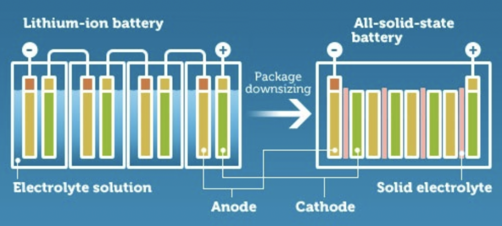Dear Reader,
If you’ve been following electric vehicle news over the past few months, you’ve probably heard a lot about recent advancements made by Toyota (NYSE: TM) in the development of all-solid-state batteries (ASSBs).
These batteries, which the company is planning to start introducing in the second half of the decade across their entire line of EVs, promise to drastically improve both range and charge time, with the most advanced models projecting ranges of over 900 miles and charge times of as little as 10 minutes.
But what are these batteries, and what makes them so special?
Well, the "solid state" aspect of the batteries relates to the "electrolyte" — the portion of the battery through which electrons flow from the anode to the cathode.

In classic lithium-ion batteries, the electrolyte is a liquid solution that contains organic solvents as well as high concentrations of oxygen.
In a solid-state battery, the electrolyte is, as the name suggests, composed of solid phosphate and sulfide compounds and performs the same function as liquid sulfides, with some major differences in terms of performance. Join Wealth Daily today for FREE. We’ll keep you on top of all the hottest investment ideas before they hit Wall Street. Become a member today, and get our latest free report: “How to Make Your Fortune in Stocks”The Best Free Investment You’ll Ever Make
It contains full details on why dividends are an amazing tool for growing your wealth.
Oxygen Plus Organic Solvents Plus Heat…
First of all, solid-state electrolytes take up less space, giving them a higher energy density — which is what allows them to store far more energy than current benchmark designs.
Secondly, because the electrolyte is so much more compact, charging can also be achieved in far less time — which is why you see 4x and 5x improvements in charge delay.
And finally, because solid-state electrolytes contain no liquid and will not readily boil out dissolved oxygen when heated — which is a natural side effect of the charging process — the risk of the batteries physically failing becomes almost zero.
The result: an order-of-magnitude improvement in safety.
For many consumers, this is the No. 1 issue with rechargeables batteries.
You've probably seen images like this in the news:

Lithium fires are now a daily occurrence… So much so that many American cities have passed legislation regulating the sale and storage of large batteries like the kind you find powering e-bikes.
With diminished fire risk and radically improved performance specs, solid-state batteries have long been thought to be the answer to all of the traditional Li-ion shortcomings.
So kudos to Toyota for taking these steps, but that also begs the question: What’s next?
ASSBs Are an Improvement… This Is a Revolution
Solid-state batteries, as it stands, will likely come to market in the next few years and slowly become the standard for the EV industry, gradually pushing liquid electrolyte designs out the same way DVDs killed off VHS tapes.
But what if something else, something completely new altogether, came along and disrupted the battery market before any of this could happen?
What if a battery were introduced that took not 10 minutes to charge from 20% to 80%… but just one minute?
And what if the company that brought this product to consumers weren't a $240 billion company like Toyota but a complete unknown less than 1/1,000th the size?
Do you think that would be enough to give current lithium investors pause?
Right now exactly what I just described is taking place, albeit very quietly.
Growth-Minded Speculators, Pay Special Attention
A company you’ve likely never heard of, based out of the eastern Australia city of Brisbane, is developing a completely new battery that makes ASSBs look downright obsolete.
Charge times for standard EV battery packs are down to less than a minute.
Expected range is upward of 1,000 miles.
And overall battery life (as measured by charge/discharge cycles) is expected to be somewhere in the neighborhood of 1 million miles or more — meaning the battery packs of tomorrow’s EVs will outlast every other major system in the car — quite possibly the driver himself.
These batteries are more than just a science project.
They’re already in production, with early production runs of coin- and pouch-style batteries already coming off the assembly lines.
They could be in stores as soon as next year, with larger, more complex systems to power cars, boats and buses not far behind.
Like I said, the company that’s making these modern marvels is a relative unknown, yet it’s already challenging the establishment with a product that could redefine the rechargeable battery space.
Forbes and Fortune Won't Help You
It’s a quiet revolution, but the story is gaining traction.
Shares of this company are already public and trading on not one but two North American exchanges.
As always, the retail investor is the last to know, but this quiet revolution is simply too important and too world-altering to stay in the dark for long.
My premium subscribers have known about this company for months now.
Today, the Wealth Daily readership can finally get up to speed.
My detailed video presentation is now available for instant access.
It’s free and it’s quick, and I promise that you will walk away with a completely fresh perspective on the entire rechargeable battery space.
To watch, just click here and sit back.
Fortune favors the bold, Alex Koyfman His flagship service, Microcap Insider, provides market-beating insights into some of the fastest moving, highest profit-potential companies available for public trading on the U.S. and Canadian exchanges. With more than 5 years of track record to back it up, Microcap Insider is the choice for the growth-minded investor. Alex contributes his thoughts and insights regularly to Energy and Capital. To learn more about Alex, click here.



